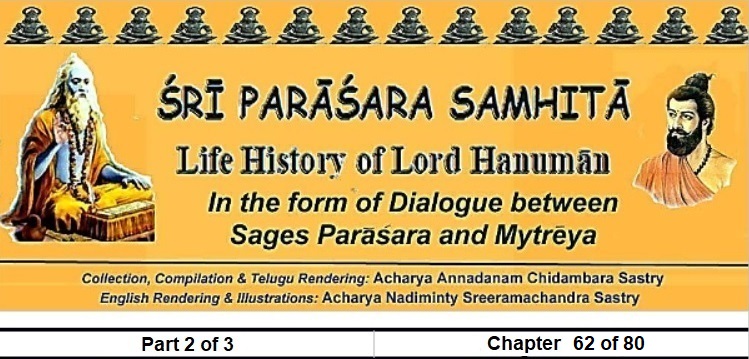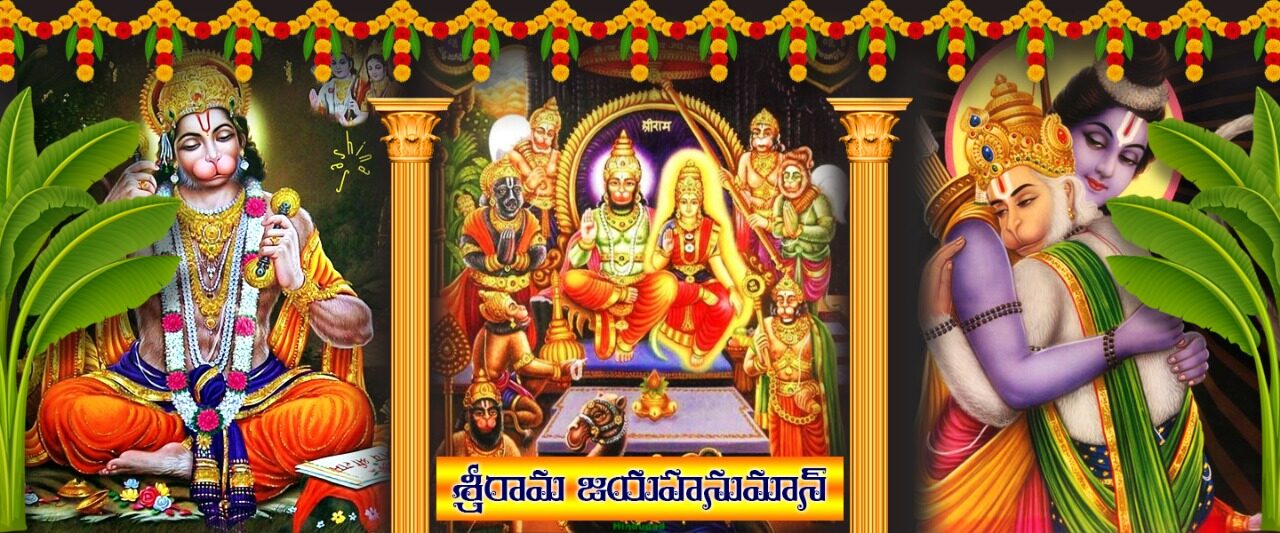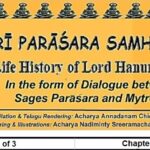
62nd Chapter (Dwişaşţitama Paţalah)
“Feature of Hanumān Idol”
(Hanumadvigrahakşaņam)
श्रीमैत्रये:
पराशर नमस्तुभ्यं संशयं मे निवारय
हनुमद्विग्रहाणां च जघन्यस्पर्शनं यदि
प्रायश्चितं भवेत्तस्य किं वा तथ्येन शुध्यति।। 1
Mytrēya:
“Oh! Great Sage Paraāśara! Very kind one! I bow to thee. Clarify my doubt. How the atonement (prāyaścitta) process has to be carried out if the idol of Hanumān is touched by a mean one? How can it gets purified (suddhi)? (1)
श्रीपराशरः
प्रतिमां शोधयेत्सम्यक् तिंत्रिणीफलकर्दमैः
पव्म्चामृतैःपव्म्चगव्यैः मार्जयेत्पव्म्चपल्लवैः।। 2
ŚrīParāśara:
Atonement of the Idol
Oh! Mytrēya! If the idol of Hanumān has undergone a miserable touch, it has to be rubbed well with the juice of the sour tamarind kernels. Then it has to be cleaned with the Five Nectars (pańcamŗ t– water + milk + curds + ghee + honey), Five Cow Stuffs (pańcagavya – cow dung + cow urine + cow milk + cow milk curd + cow milk ghee) and Five Leaves (pańcapallava – leaves of Ficusreligiosa + India Fig, Ficusracemosa + banyan + mango + white fuited fig, Ficusinfectoria), in that order. (2)
स्नापयेद्द्वादशावृत्या पुरुषसूक्तविधानतः
हुनेच्च द्वादशाव्त्या सप्ताक्षर्या हनूमतः।। 3
Then the idol has to be bathed 12 times according to the method of Puruşasookta (Vedic hymns about Brahman, the Supreme Personality). Then the Fire Sacrifice has to be performed 12 times reciting the Hanumān Seven Lettered mantra. (3)
ब्राह्मणान्भोजयेत्पश्चात् स्वस्वसक्त्यनुसारतः
हनुमद्विग्रहं स्पृष्टवा दक्षिणेन करेण वै
आव्म्जनेयस्य गायत्रीं जपेदष्टोत्तरं शतम्।। 4
Then, according to one’s own capacity, feast Supreme-being oriented gentle scholars that are worth worshipping. While touching the idol of Hanumān with the right hand, one has to recite the Hanumān Gāyatri 108 times. (4)
बुद्धेः प्रमादादालस्याच्छ्वपचस्पर्शनादपि
अग्नितप्ताद्भवेच्छुशुद्धिः गृहदाहे थवा मुने।। 5
If it (the atonement) is delayed due to misunderstanding or if some mean personality touched the idol or if it is burnt in a fire or the very house is burnt, (5)
प्राणप्रतिष्ठामारभ्य संस्क्रुर्यात्पूर्ववत्पुनः
स्थावराणां च मूर्तीनां कदाचित्स्खलनं यदि
नीचस्पृष्टाय आख्यातः प्रायश्वित्तविधिर्मुने।। 6
All the atonement procedures have to be carried out right from the life-imparting (prāņapratişţa) stage. (6)
तेनैव विधिना सम्यक्संस्कुर्यात्पूज्यविग्रहान्
संवत्सरर्तुमासेषु पूजासंस्कारवर्जितान्।। 7
If the due annual, seasonal or monthly worships to the Hanumān idol are not performed, proper atonement has to be performed well using the above procedure. (7)
मार्जयेत् पुरूषैस्सूक्तैः प्रतिमां तु यथाविधि
ततः परं यथाशक्त्या ब्राह्मणान्भोजयेन्मुने! 8
The worshiping statue has to be atoned, as stipulated, according to the method of Puruşasookta. After that, as per one’s capacity, scholarly people have to be fed. (8)
श्रोत्रियाणां द्विजातीनां सर्वदा नियतात्मनां
सन्तर्पणं विधिवत् प्रायश्चित्तविधिःस्मृतः।। 9
Know that the atonement procedure includes organising feast to even-minded Brāhmins well-versed in Vēdas. (9)
सन्तर्पणं विना मन्त्रो दैवतं गुरुरन्यथा
कदाचिन्न प्रसीदन्ति तस्माद्ब्राह्मणभोजनम्।। 10
Without a feast, a mantra or God or Guru will not result in benevolence. That is why a feast for the scholars is proposed. (10)
हनुमत्प्रतिमोत्कर्षं वक्ष्यामि मुनिपुङ्गव
यत्प्रभावादशेषास्तु सिध्यन्ति च मनोरथाः।। 11
Glory of the Hanumān Idol
I will tell the glory of the Hanumān idol. Oh! Great sage! All the desires are getting fulfilled under its influence. (11)
श्वेतार्कमूलं संगृह्ना भानुवारे शुभे दिने
अंगुष्ठमात्ररूपेण तत्सर्वाकारतो पि वा
तेनैव प्रतिमां कुर्याद्धनुमद्रूपशोभिताम्।। 12
Make a shining Form of Hanumān, thumb-sized or the size of its knuckle on an auspicious Sunday, using the root of crown-flower (Calotropisgigantean) plant. (12)
प्राणप्रतिष्ठां कुर्वीत ब्राह्मणान्भोजयेत्ततः
रक्तवस्त्रै रक्तगन्धै रक्तमाल्याक्षतैरपि
पूजयेन्मन्दवारेषु पव्म्चसु प्रतिमां हरेः।। 13
After the life-impartation (prāņapratişţa) to it, a feast has to be performed. Worship that Hanumān form on five Saturdays with red clothes, red sandal, red little garlands and red sacred rice (akşiţāni). (13)
ततः प्रसन्नो भवति हनुमान्वीरमारुतिः।। 14
Hanumān, the courageous son of the Wind God will be benevolent, if His Crown-Flower-Root Form is worshipped in this manner. (14)
हनुमत्प्रतिमां गृष्ट्वा युध्यन्नपि महाहवे
वरैर्न हन्यते क्वापि शत्रुभिर्नाभिभूयते
अस्त्रशस्त्रप्रहारो पि पीड्यते नैव कुत्रचित्।। 15
Crown-Flower-Root Form of Hanumān
If one enters a great war after seeing such a Hanumān form, enemies will not able to look at, what to talk of killing. No weapon (astra) or mantra operated weapon (śastra) can harm. (15)
श्वेतार्कमूलप्रतिमा पूज्यते हनुमन्मयी
गृहीतस्याचिरेणैव सुसिद्धा सर्वसम्पदः।। 16
All riches accrue to one that worshipped Hanumān form made of such a white root. (16)
भूतपे्रेतपिशाचाद्याः पलायन्ते भयावृताः
व्याधयो पि न बाधन्ते नाग्निचैरादिसाध्वसम्
सिध्यंति सर्वकार्याणि नात्र कार्या विचारणा।। 17
Devils, dead forms, wandering spirits (bhootaprētapiśaca) and others will get frightened and run away. Diseases do not bother. There will be no fear of fire and thieves. There is no doubt that their activities will be hindered. (17)
श्वेतार्कवृक्षो यत्रास्ते हनुमत्प्रीतिकारणः
नित्यं सन्निहितस्तत्र हनुमान्भक्तवत्सलः।। 18
Whereever the crown-flower plant that is dear to Hanumān exists, Hanumān will always remain there as a close friend. (18)
उपास्य भगवान्शम्भुः पुरा श्वेतार्कमारुतिम्
इन्द्राद्यैरप्यजेयानि त्रिपुराणि जिगाय सः।। 19
Once upon a time, Śiva himself worshiped the Hanumān form made of white crown-flower root, before destroying the devil Tripurāntaka, who was undefeatable by even Indra and other gods. (19)
तस्मात्प्रमादरहितो ह्येवं सर्वेषु पर्वसु
उपास्यश्चेस्प्सितावाप्त्यै श्वेतार्कहनुमत्प्रभुः।। 20
Hence, for getting all desires fulfilled, Hanumān form made of white crown-flower root on all festivity days. (20)
यदा कदाचित्काले पि जन्तोर्वै जयकांक्षिणः
श्वेतार्कहनुमत्पूजा सर्वकाम्यार्थदायिनी।। 21
Worshiping the white crown flower root Hanumān form gives success at all times. (21)
पद्मादीन्यासनान्याहुः जपकाले मनीषिणः
आसनेभ्यश्च सर्वेभ्यः शस्तं वीरासनं स्मृतम्।। 22
Ideal Posture for Recitation
Scholars told that postures like the lotus sitting-posture (padmāsana) are good for reciting the mantras. Veerāsana (posture of the courageous) is said to be the best amongst such postures. (22)
वीरासनं न युक्तं स्याद्देवतागुरुसन्निधौ।। 23
Sitting in Veerāsana before deities and Gurus is forbidden. (23)
जपतस्सुबहून्मंत्रान् प्राप्ते महति सङ्कटे
छन्दर्षिदेवताध्यानन्यासप्राणायामैस्तथा
दशवारं जपं कुर्यात् मूलमन्त्रस्य यत्नतः।। 24
It is forbidden too to stop recitation of a mantra during difficult times, because one has not learnt many mantras. If that happens, one has to recite the other mantras after purposefully performing meter, seer, ruling lord, meditation, hand gesticulations and controlled breathing (prāņāyāam), reciting the root mantra. (24)
देवानामङ्गमंत्राणां यथाशक्ति जपःस्मृतः
पुरस्चरणहोमं तु न्यासध्यानादिकं क्रमात्
पृथक्पृथक प्रकुर्वीत मूल मंत्राङ्गमन्त्रयोः ।। 25
One has to recite, to one’s capacity, the body part (ańgapooja) mantras. The repetitions, fire sacrifice, hand gesticulation, meditation and others are to be performed separately for the root mantra and body-part mantra separately. (25)
नित्यहोमं तु मन्त्राणां प्रधानस्य मनोर्मुने!
न्यासध्यानादिकंकुर्याद्धोममेवाङ्गमंत्रके।। 26
Oh! Sage Mytrēya! But the regular fire sacrifice is for the main mantra only. For the body-part mantras, first perform hand gesticulations, meditation and others and then the fire sacrifice. (26)
हनुमन्मन्त्रविद्यासु काचिद्गुह्या महामुने!
सप्तमन्त्रात्मका नाम सप्तमन्त्रमयी स्मृता ।। 27
The Seven Mantra Soul
In the knowledge pool of Hanumān mantras there is a secret mantra. Oh! Sage Mytrēya! That is the saptamantrātmaka or one with seven mantras. (27)
सप्तानामपि मन्त्राणां जपो होमश्च तर्पणम्
पृथक्पृथक प्रकुर्वीत मालामन्त्रेष्विवानघ।। 28
Oh! Sinless one! One has to perform the recitation, fire sacrifice, and water giving (tarpaņa) separately just like for the root mantra. (28)
भोजनन्तु समष्ट्येव सर्वेषामथवांशतः
यथाशक्त्यनुसारेण वित्तशाठ्यं न कारयेत्।। 29
Offering of meals has to be performed to one’s capacity together for all the mantras. (29)
सप्तमंत्रात्मिकाविद्या पव्म्चाननहनूमतः
प्राणात्यये पि नो देया यत्किव्म्चिद्द्विजजन्मनि।। 30
The seven-mantra-knowledge should never be given to any other Brahmin, even if one is about to lose one’s life. (30)
सौवर्णमुत्तमं प्रोक्तं राजतं मध्यमं स्मृतम्
अधमं ताम्रमित्याहुः निष्फलं दारुविग्रहम्।। 31
Idol-making and their Care
An idol made of gold is the best, one made of silver is midways, the one made of copper is the least effective and the one made of wood is of no use. (31)
सौवर्णरौप्यशकलसंमिश्रं यदि ताम्रकम्
तदनुत्तममित्याहुः गुणास्संसर्गसम्भवाः।। 32
But the most effective is the idol made of copper, in which gold and silver pieces are incorporated, because the good features of all the three come together. (32)
श्वेतार्कविग्रहः श्लाघ्यः कृष्णागुरुमयस्तथा
सर्वेषामाश्रमाणां हि सद्यस्सिद्धिकरः स्मृतः।। 33
But the one made of white crown flower root is the most appreciable. Similarly the idol made of black gum (Black gum or resin of Aguru tree) is also very good. It gives result for actions (kāryasiddhi) to people of all classes. (33)
कदाचिदपि न श्रेयान् गृहीणां दन्तविग्रहः।। 34
Never is it good to use idols made of ivory that are commonly kept in houses. (34)
नौकातरणवेलायामष्वाद्यारोहणे तथा
शिरसि स्थापयेद्देवं नौकाद्यां तु न निक्षिपेत्।। 35
When one is sailing in a boat or riding a horse, the Hanumān idol has always to be carried on one’s head, but never kept anywhere. (35)
अवतीर्य च नौकादेः संस्कुर्यात्प्रतिमां मुने
अन्यथा प्रत्यवायः स्याद्देवो वा प्रतिमां त्यजेत्।। 36
Oh! Great sage Mytrēya! A purifying ritual (samskāra) has to be performed after alighting from a ship or a horse. Otherwise it will be an error. The presiding lord will leave the idol. (36)
रजोमलिनरूपासु देवताप्रतिमासु च
क्षणाद्गच्छति सान्निध्यं देवता याति संस्कृता।। 37
Gods run away in no time from a lord’s idol form, covered with dust (undesirable material). (37)
न जन्तुच्छायया युंज्यात्सजलार्द्रतया सदा
न च दिग्वाससा धीमान् देवताप्रतिमां शुभाम्।। 38
The idols should never be kept wet with water or falling in the shade of animals. Clean idols of gods should never be kept naked. (38)
पर्वसु स्नापयेन्मूर्तिं ताम्ररौप्यसुवर्णकाम्
यद्यपर्वणि मोहेन सिंचेद्भवति दोषभाक्।। 39
The idols made of gold, silver or copper should be bathed on festive days. It is an untoward act to just wet the face of the idol, even on non-festive days. (39)
तस्मान्मलिनरूपाणां मालिन्यविनिवृष्त्तये
सूक्त्यब्भक्षणगन्धाद्यैस्संस्कुर्यात्तु यथाविधि।। 40
Hence the idols dirtied by impurities have to be systematically purified (samskuryātu) through recital of puruşasūkta (invocation hymn of the Supreme Being), the five nectars (pańcāmŗta), serving feast and sandal scent and other materials. (40)
मूलमंत्रं समुच्चार्य पत्रपुष्पफलादिभिः
सर्वदा भक्तियोगेन पूजयेत्स्वेष्टदेवताम्।। 41
The desired God has always to be worshipped with devotion by reciting the root mantra and offering leaves, flowers, fruits and others. (41)
तत्पूजनफलं वक्तुं न शक्नोति चतुर्मुखः
जापकस्तत्क्षणादेव पुनश्चर्याजपादिकात्
वाव्म्छितं फलमाप्नोति दुर्लभं देवदानवैः।। 42
Fruits of Worship of such Idol
Even Brahma, the Creator cannot describe the good fruit that accrues on worshipping the idol of Hanumān. The one so reciting and performing the repetition (punaścaraņ) that even gods and demons cannot obtain. (42)
कर्तिके मासि शुद्धात्मा धात्रीपत्रफलैरपि
संपूजयेद्धनूमन्तं तदानन्तयाय कल्प्यते।। 43
Hanumān has to be worshipped with an undisturbed mind using gooseberry leaves during the 8th lunar month (kārteeka). Worshipping so will result in infinite good results. (43)
धात्रीफलस्थदीपेन देवं नीराजयेद्यदि
न पश्यति तमोलोकान् महापातकवानपि।। 44
If one puts a lamp (cotton wick) in a gooseberry fruit and gives neerājanam (worshiping with a lamp, normally, by burning camphor), that one will go to heaven even if he has performed the basest misdeeds. (44)
![]()
इति श्रीपराशरसंहितायां श्रीपराशरमैत्रेयसंवादे हनुमद्विग्रहप्रकारकथनं नाम द्विषष्टितमः पटल
Thus ends the 62nd Chapter “Feature of Hanumān Idol”

Click here to visit the Contents of the Part 2.







Be First to Comment